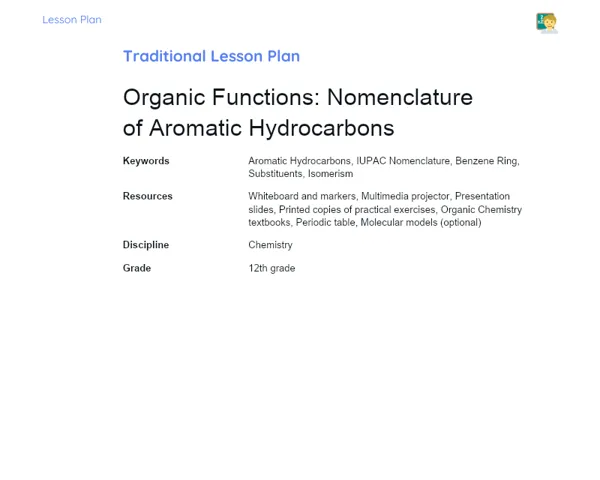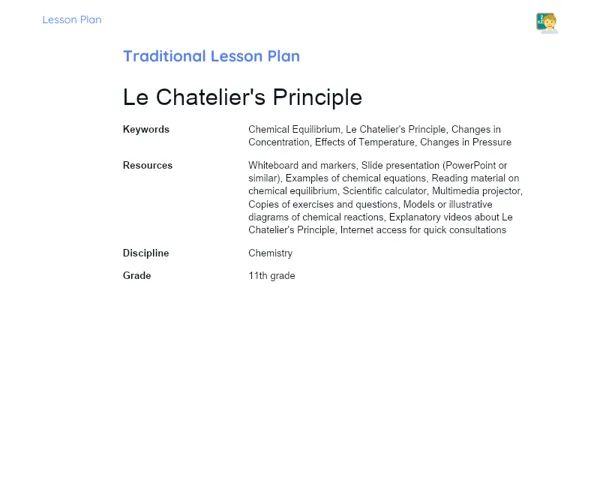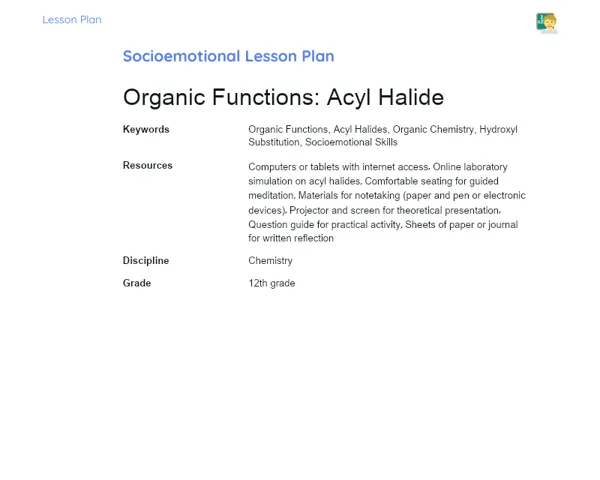Lesson Plan Teknis | Eutectic and Azeotropic Mixtures
| Palavras Chave | Eutectic Mixtures, Azeotropic Mixtures, Conventional Mixtures, Heating Graphs, Practical Experiments, Chemical Industry, Industrial Applications, Welding, Distillation, Metal Alloys, Alcoholic Beverages, Perfumes |
| Materiais Necessários | Beakers, Thermometers, Bunsen Burners, Pre-prepared Mixtures (eutectic, azeotropic, and conventional), Tripods, Supports, Video on distillation and eutectic alloys, Materials for plotting graphs (graph paper, pens, etc.) |
Objective
Duration: 15 - 20 minutes
The aim of this stage is to ensure that students grasp the core concepts of eutectic, azeotropic, and conventional mixtures, as well as how to interpret heating graphs. This understanding is essential for developing practical skills relevant in various industries, particularly in chemical and materials fields.
Objective Utama:
1. Differentiate between eutectic mixtures, azeotropic mixtures, and conventional mixtures.
2. Identify the mixture based on its heating graph.
Objective Sampingan:
- Appreciate the significance of eutectic and azeotropic mixtures in industrial applications.
Introduction
Duration: (15 - 20 minutes)
The aim of this stage is to ensure that students grasp the core concepts of eutectic, azeotropic, and conventional mixtures, as well as how to interpret heating graphs. This understanding is essential for developing practical skills relevant in various industries, particularly in chemical and materials fields.
Curiosities and Market Connection
Eutectic Mixtures: Used in refrigeration systems and the creation of metal alloys like solders and dental materials. Azeotropic Mixtures: Essential in the perfume and alcohol industries, where regular distillation fails to separate components effectively due to the formation of an azeotropic mixture. Industrial Application: In petrochemicals, comprehending azeotropic mixtures is key for oil refining, while in electronics, eutectic mixtures ensure the integrity of solders used in assembling integrated circuits.
Contextualization
Mixtures play a vital role across scientific and engineering disciplines. Eutectic and azeotropic mixtures, in particular, have unique properties that make them indispensable in industrial settings. For instance, eutectic mixtures are widely used in welding and the creation of metal alloys due to their stable melting points. Conversely, azeotropic mixtures are crucial in the distillation sector, including the production of spirits and solvents, where component separation poses a significant technical hurdle.
Initial Activity
Provocative Question: "Did you know that some mixtures can't be separated using simple distillation, even when boiled?" Short Video: Present a 3-minute video showcasing the distillation of azeotropic mixtures and the manufacture of eutectic alloys to visually and practically illustrate the concepts.
Development
Duration: 45 - 50 minutes
The aim of this stage is to consolidate the knowledge students have gained through practical and reflective activities, ensuring they can apply theoretical concepts to identify and analyze mixtures in real-life situations. This skill set is crucial for preparing them for the technical challenges they will face in the job market, especially in chemical and materials industries.
Topics
1. Definition and characteristics of eutectic mixtures
2. Definition and characteristics of azeotropic mixtures
3. Differences between eutectic, azeotropic, and conventional mixtures
4. Understanding heating graphs to identify types of mixtures
Thoughts on the Subject
Encourage students to reflect on the significance of eutectic and azeotropic mixtures in industry. Discuss how these mixtures can impact the efficiency and quality of end products. Consider the relevance of technical knowledge for identifying and managing these mixtures in industrial settings and its influence on a company's competitive edge.
Mini Challenge
Practical Challenge: Identification of Mixtures
Students will engage in a hands-on experiment to identify eutectic, azeotropic, and conventional mixtures by analyzing heating graphs.
1. Divide the class into groups of 4-5 students.
2. Provide the necessary materials for the experiment: beakers, thermometers, Bunsen burners, pre-prepared mixtures (one eutectic, one azeotropic, and one conventional), tripods, and supports.
3. Instruct students to gently heat each mixture while recording temperatures at regular intervals.
4. Have students plot the heating graphs for each mixture.
5. Encourage groups to analyze the graphs and deduce the type of mixture based on the observed properties.
Foster practical skills in identifying mixtures and interpreting heating graphs, enhancing the application of theoretical concepts in an experimental setting.
**Duration: 30 - 35 minutes
Evaluation Exercises
1. Explain how eutectic mixtures differ from azeotropic mixtures.
2. Provide an example of an industrial application for each mixture type and explain your reasoning.
3. Using a given heating graph, identify if the mixture is eutectic, azeotropic, or conventional, and support your answer.
4. Describe methods to separate an azeotropic mixture and a eutectic mixture in industrial scenarios.
Conclusion
Duration: (15 - 20 minutes)
The aim of this stage is to ensure students integrate and consolidate their learning throughout the lesson, making clear connections between theory and practical application. The discussion encourages a more in-depth understanding within context, while the summary and closing underscore the relevance of the topic for real-world applications and employment.
Discussion
Guide students to share their insights and findings regarding the different types of mixtures and the corresponding heating graphs. Ask how the practical experiment aided in solidifying their theoretical understanding. Encourage reflection on the challenges faced during the activities and the solutions implemented to overcome them. Motivate students to discuss the industrial relevance of eutectic and azeotropic mixtures, underlining the importance of this knowledge in the job market.
Summary
Review the main concepts related to eutectic, azeotropic, and conventional mixtures. Highlight the differences between these types and their behavior in heating graphs. Emphasize the roles of eutectic mixtures in welding and metal alloy production, alongside the importance of azeotropic mixtures in distillation, perfume creation, and alcoholic beverage manufacturing.
Closing
Wrap up the class by discussing how the integration of theory and practice has deepened understanding of the topic. Stress that the knowledge gained is not just for academic purposes but is vital for practical applications in numerous industrial sectors. Highlight the importance of ongoing learning and the ability to apply theoretical concepts in real-world scenarios, which is highly regarded in the job market.



